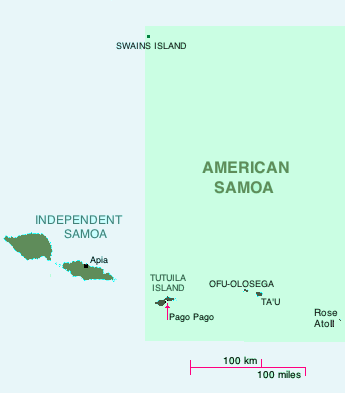
World Factbook as of October 2014: American Samoa has a traditional Polynesian economy in which more than 90% of the land is communally owned. Economic activity is strongly linked to the US with which American Samoa conducts most of its commerce. Tuna fishing and tuna processing plants are the backbone of the private sector with canned tuna the primary export. The two tuna canneries account for 80% of employment... Tourism is a promising developing sector."
Estimated per capita GDP
2007: $8,000, 134th of 229 countries.
Infant mortality (deaths before the age of one year per 1,000 live births)
2011: 9.66 deaths
Average life expectancy at birth:
2011: 74.21 years
Unemployment rate
2005: 29.8%
Its 2002 export/import ratio was very negative: 30/123
Aid infusions to American Samoa from Washington are regular. In 1994 it was said to be about $700 for each person in American Samoa – about $40 million.
Density estimated for 2005: 291 persons per square kilometer, compared to only 60 for the other Samoa and 58 per square kilometer for French Polynesia. Growth estimated for 2008: minus 0.322 percent per year (an estimated population decline of 185 people, a lower number because of emigration).
People
Population
July 2014: 54,517
July 2011: 67,242
Ta'u Island population
2000 census: 873
Ofu-Olosega population
2000 census: 289
Swains Island population
2005: 37
Living in an urban area
2010: 93%
2008: 92%
Birth / death rate
2014: 22.87 / 4.68 per 1,000 population
People born in American Samoa are US "nationals."
Net migration rate
2014: A net loss of 21.64 per 1,000: These are US citizens, many going to the Hawaiian Islands or to California.
2011: A net loss of 6.63 per 1,000.
Ethnic groups
2000 census: Native Pacific islander 91.6%, Asian 2.8%, white 1.1%, mixed 4.2%, other 0.3%
Religions
Christian Congregationalist 50%, Roman Catholic 20%, Protestant and other 30%
Geography
Five volcanic islands with limited coastal plains. Two coral atolls, Rose Island (an uninhabited wildlife refuge) and Swains Island. The islands are about half way between Hawaii and New Zealand. It rains a lot, as in Somerset Maugham's story about Sadie Thompson, "Rain," except for Swains Island, which is closer to the equator, hotter as well as drier. One can walk around Swains Island in about 12 to 15 hours. Swains has a lagoon. There is no regular transportation in or out.
World Factbook: The port town of Pago Pago "has one of the best natural deepwater harbors in the South Pacific Ocean, sheltered by shape from rough seas and protected by peripheral mountains from high winds; strategic location in the South Pacific Ocean"
Government
American Samoa is territory administered by the United States Department of the Interior. Executive power is exercised by the governor. Legislative power is vested in the two chambers of the legislature, the lower chamber is the House of Representatives with 20 seats, its members elected by popular vote.
Samoans elect one non-voting delegate to the US House of Representatives. They also send delegates to the Democratic and Republican national conventions.
Capital: the port town of Pago Pago (pronounced Pango Pango).
Recent History
It was acquired in 1900 in a treaty with Germany that divided the Samoan archipelago.
2002: A court in American Samoa ordered a garment factory to pay $3.5 million to 270 workers from China and Vietnam. The court described workers cheated of wages, beaten and deprived of food.
Sources:
The World Factbook